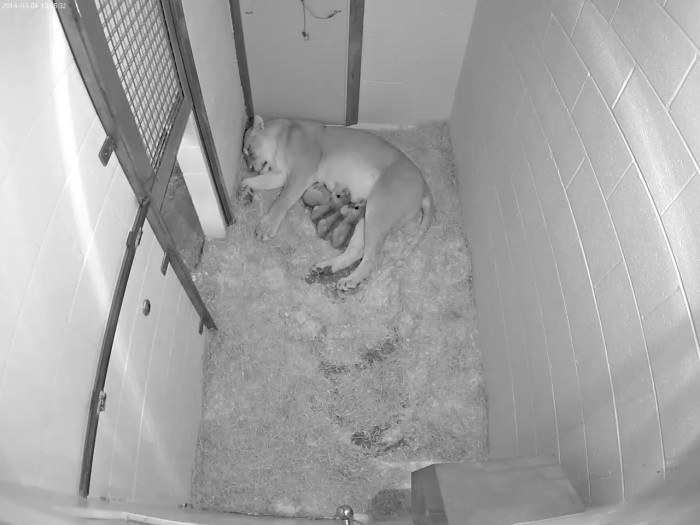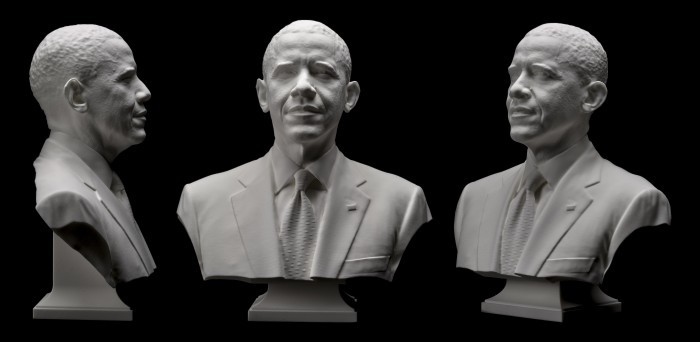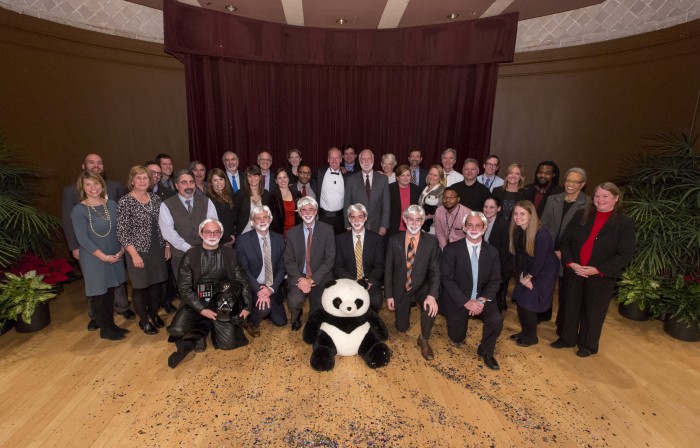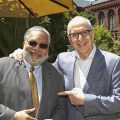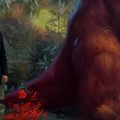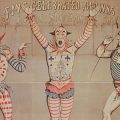Dinosaurs, design, discoveries–The Smithsonian ran the gamut in 2014
From ballgowns and Bollywood to the Big Bang, Smithsonian research and exhibitions, discoveries and acquisitions ranged around the world and beyond in 2014.
January
We rang in the New Year on an appropriately glamorous note when the gown worn by First Lady Michelle Obama to the January 2013 inaugural balls went on display at the American History Museum. This special one-year loan from the White House coincides with the centennial of the popular First Ladies exhibition and the museum’s 50th anniversary. Michelle Obama’s second inaugural gown goes on display>>

First Lady Michelle Obama’s second inaugural gown worn to the January 2013 inaugural balls (Photo by Hugh Talman)
Later in the month, Secretary Clough announced that plans to reopen the historic Arts and Industries Building on the National Mall will be indefinitely postponed. Plans for the 133-year -old building originally called for creating an interim program called Smithsonian Innovation Space. After a year of program planning and financial review, the Smithsonian concluded that the cost of rehabilitating the building for public use and operating it exceeded available funding sources at this time. The building’s roof and exterior have been structurally stabilized with $55 million from federal funds. Status of the Arts and Industries Building >>

The Arts and Industries Building was the original home of the U.S. National Museum (Photo by Eric Long)
February
One in every 100 Americans has a family connection to India. In a first-of-its-kind exhibition at the Smithsonian, the Asian Pacific American Center opened “Beyond Bollywood: Indian Americans Shape the Nation,” detailing the history of Indian Americans and their contributions to the United States from the 1700s to the present. The 5,000-square-foot exhibition remains on view at the Smithsonian’s National Museum of Natural History. Beyond Bollywood: Indian Americans Shape the Nation >>
Whale graveyards—and the mass whale strandings that lead to them—have puzzled people since ancient times. A team of Smithsonian scientists have finally solved the mystery of how and why these whales die by studying a massive graveyard along a remote desert highway in Chile containing the fossil bones of at least 40 dead whales and a slew of other marine victims. Known locally as Cerro Ballena, or Whale Hill, it is the densest site for individual fossil whales and other extinct marine mammals ever found. The Mysterious Case of Cetacean Expiration >>

Chilean and Smithsonian paleontologists study several fossil whale skeletons at Cerro Ballena, next to the Pan-American Highway in the Atacama Region of Chile, 2011. (Photo by Adam Metallo)
March
March came in like a lion—four lions, to be exact—when 9-year-old African lion Shera gave birth to a litter March 2 at the Great Cats exhibit at the National Zoo. These cubs are the second litter for Shera and the fifth for 8-year-old father, Luke. Recently, Luke also sired 10-year-old Nababiep’s two female cubs born Jan. 24. We’re busting with pride over our four new lion cubs >>
On March 13, The Smithsonian Institution’s Board of Regents announced that Dr. David J. Skorton, president of Cornell University and a board-certified cardiologist, will become the 13th Secretary of the Smithsonian, effective July 2015. Dr. Wayne Clough,12th Secretary, retired Dec. 31, 2014. Albert Horvath,previously the Under Secretary for Finance and Administration and Chief Financial Officer of the Smithsonian, will serve as Acting Secretary Jan. 1, 2015 through June 30. Regents name David Skorton as the 13th Smithsonian Secretary >>
Almost 14 billion years ago, the universe we inhabit burst into existence in an extraordinary event that initiated the Big Bang. In the first fleeting fraction of a second, the universe expanded exponentially, stretching far beyond the view of our best telescopes. All this, of course, was just theory. In March, Smithsonian scientists announced the discovery of gravitational waves that amount to the “first tremors of the Big Bang.” This is big, indeed! Have we found evidence for the origins of the universe? >>
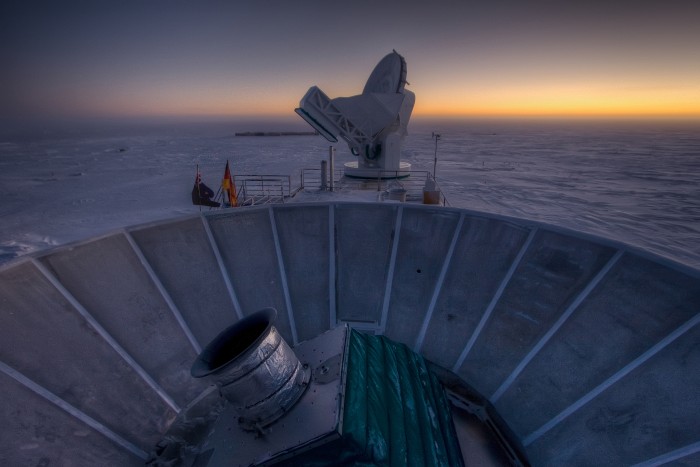
The sun sets behind BICEP2 (in the foreground) and the South Pole Telescope (in the background). (Credit: Steffan Richter)
April
Marian Anderson made civil rights history on the steps of the Lincoln Memorial in 1939. And she looked fabulous when she did it. The orange-and-black velvet ensemble she wore during her Easter Sunday performance has joined the collection of the National Museum of African American History and Culture. Anderson was, by all accounts, a meticulous dresser, with an elegant array of gowns and suits to rival that of any performer of the time. “She carried herself in the way she wanted to be seen,” says curator Dwandalyn R. Reece. It wasn’t only Marian Anderson’s voice that dazzled the crowd in 1939 >>

Beneath Anderson’s coat is a bright orange velour jacket, a form-fitting number trimmed in gold with turquoise buttons, now among the collections at the Smithsonian. (Photograph by Robert S. Scurlock. Scurlock Studio Records, Archives Center, National Museum of American History)
The Smithsonian welcomed the “Nation’s T. Rex” April 15 with special programs, a dance contest, virtual reality and more. The Nation’s T. rex, a nearly complete Tyrannosaurus rex skeleton, will be the centerpiece of the Natural History Museum’s new 31,000-square-foot dinosaur and fossil hall, which is slated to open in 2019. The current dinosaur and fossil hall closed to the public April 27 in preparation for the largest, most extensive exhibition renovation in the museum’s history. It’s here! >>
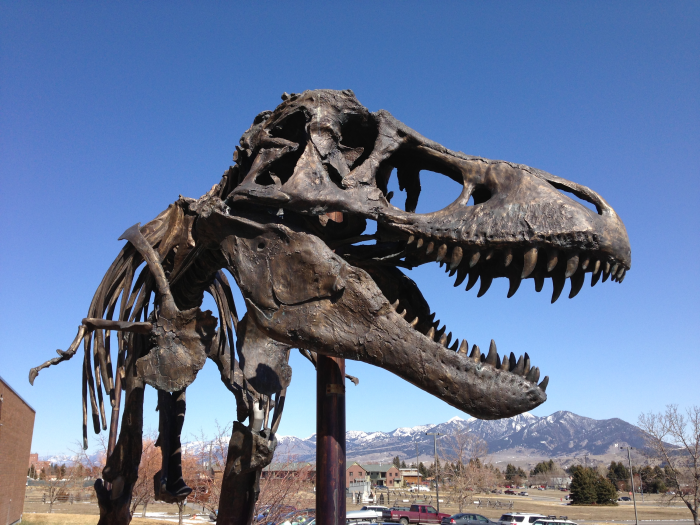
A bronze replica of the Nation’s T. rex towers over Montana State University’s Museum of the Rockies, Bozeman, Mont. The actual T. rex specimen arrived at the National Museum of Natural History on April 15, and will be the centerpiece of the museum’s new 31,000-square-foot dinosaur and fossil hall, which is slated to open in 2019. (Photo by Kirk Johnson)
May
In May, the Torch highlighted the tropics. Secretary Clough shared his final travel journal, recounting his trip to Carrie Bow Cay Marine Station off the coast of Belize. From this tiny island, Smithsonian researchers study some of the most diverse and pristine marine environments in the world. On the Road in Belize >>

The Caribbean Coral Reef Ecosystems Program is a long term field site dedicated to investigations of coral reefs and associated ecosystems. Field operations are based at the Carrie Bow Cay Field Station on the Meso-American Barrier Reef in Belize. (Photo by R. Ritson-Williams)
Human activity has had an unintended consequence in the increase of a debilitating tropical disease. Bert Van Bocxlaer of the Natural History Museum and an international team of researchers have found that manmade changes in Africa’s Lake Malaŵi are the driving force behind an increase in a debilitating tropical disease caused by parasitic flatworms. They may also have found a solution. 250 million suffer from parasitic disease worldwide. Smithsonian scientists may have a solution.>>

National Museum of Natural History scientist Bert Van Bocxlaer and an international team of researchers revealed that anthropogenic changes in Africa’s Lake Malaŵi are a driving force behind the increase of schistosomiasis, a debilitating tropical disease caused by parasitic flatworms that affects 250 million people worldwide and threatens 600 million more. (Photo courtesy of Van Bocxlaer et al. (2014), Trends in Parasitology 30 (5):217-220.)
June
In June we joined Secretary Clough as he explored the National Anthem sing-along planned by the American History Museum to celebrate the 200th anniversary of the Star-Spangled Banner and met some of the surprising folk who celebrated with us. Raise it Up! >>
The Hirshhorn Museum and Sculpture Garden marked its 40th anniversary in June with new exhibitions and the announcement of a new director. Melissa Chiu, museum director and senior vice president for Global Arts and Cultural Programs for the Asia Society in New York City, became the museum’s director, effective Sept. 29.Melissa Chiu is the Hirshhorn’s new director >>
Bill McShea, ecologist at the Smithsonian Conservation Biology Institute and the Smithsonian’s “panda guy,” is baffled by the public’s love affair with the critically endangered critters. In a June TED talk, McShea described “panda sickness,” a modern obsession with panda bears despite the fact that they are, as he says, just bears. Other creatures are just as rare and endangered, there are plenty of animals that are just as adorable, so why the fascination with pandas? McShea hilariously explains why our inexplicable affection for this “average bear” is a good thing for the world. Are pandas the Bitcoin of the natural world? >>
July
The annual Smithsonian Folklife Festival featuring the cultures of China and Kenya was the highlight of the month of July. Albert Tong, a video production intern at the Center for Folklife and Cultural Heritage, who also runs the production company, Center Peace Cinemas, created a stirring video portrait of the festival. Watch One Village: China and Kenya >>
The 2014 festival aimed to be the most eco-friendly and sustainable event ever held on the National Mall. The festival draws thousands of people each year, who in turn, create thousands of pounds of trash—everything from plastic water bottles to discarded forks and food wrappers to abandoned shopping bags. The CFCH has worked has worked for several years to create a more sustainable and eco-friendly festival and this year’s festival is breaking records. Sarah Gaines and Ridley Vann, interns with the Office of Facilities Management and Reliability, compiled the highlights from the greenest festival yet. It’s not easy being green, but it’s getting easier >>

The sustainability team collected 19 bags of compostable material from just one station in only three hours. (Photo by Sarah Grimes)
August
The Smithsonian launched our Transcription Center website in August and asked for volunteers to help unlock the content contained in thousands of digitized documents, such as handwritten Civil War journals, personal letters from famous artists, 100-year-old botany specimen labels and examples of early American currency. With the help of hundreds of volunteers around the world we are now transcribing the Smithsonian’s collection in days, rather than decades Replacing the pen with the pixel>>
A man, a plan, a canal: Panama! August 15 marked the 100th anniversary of the Panama Canal. Smithsonian historian Pamela Henson wrote about the canal’s history and the Smithsonian’s long connection with Panama in this post. Connecting the oceans: The 100th anniversary of the Panama Canal >>
Remember the olinguito? The adorable combination of teddy bear and meerkat immediately became a top contender for world’s cutest animal when it stepped into the spotlight in 2013. In August we reported on what we’ve learned about this elusive creature since then. Crowdsourcing the olinguito >>

This baby olinguito was found in a nest 40 feet above the ground in a large dead bromeliad tree. (Photo by Juan Rendon taken at the Mesenia-Paramillo Nature Reserve in Colombia)
September
One hundred years after the extinction of the passenger pigeon, the nation’s top avian science and conservation groups published State of the Birds 2014—the most comprehensive review of long-term trend data for U.S. birds ever conducted. The authors call the results unsettling. The bad news? Bird populations are down in many key habitats. The good news: Conservation efforts work–if they’re applied. “State of the Birds” Report Assesses the Health of the Nation’s Birds >>

The State of the Birds 2014 report found that red knots and other shorebirds are among the most threatened groups in the U.S. More than half of U.S. shorebird species are on the report’s Watch List—a list of 230 species that are currently endangered or at risk of becoming endangered without significant conservation. (Photo by Gerrit Vyn)
We’ve been depressed ever since Pluto was demoted to non-planet in 2006. After all, in the words of one esteemed scientist, ”A dwarf hamster is still a hamster.” Is it time to revisit the question? In September, the Harvard-Smithsonian Center for Astrophysics hosted a debate among three leading experts in planetary science, with the goal of finding a definition of a planet that the eager public audience could agree on. Is Pluto a planet? The votes are in! >>

Pluto (left) and Charon (right) dominate this view of the outer solar system. Charon is about half the size of Pluto. Pluto also hosts four tiny moons – Nix, Hydra, Kerberos, and Styx – two of which are seen as small crescents at top left and right. In the distance, a faint Sun illuminates dust within the asteroid belt. (Image by David A. Aguilar (Harvard-Smithsonian Center for Astrophysics)
October
The Smithsonian’s first completely green research lab opened at the Environmental Research Center in Maryland. In October, The Torch reported on what will be the Smithsonian’s first LEED-Platinum building: the Charles McC. Mathias Laboratory. The vision for a more sustainable lab emerged in the 1990s. Six years ago, SERC director Tuck Hines shared the idea with the then-new Secretary of the Smithsonian, Wayne Clough, on his first visit to the SERC campus. Fittingly, Dr. Clough was there to cut the ribbon for the lab’s grand opening. Mathias Lab opens new era of sustainability at the Smithsonian >>
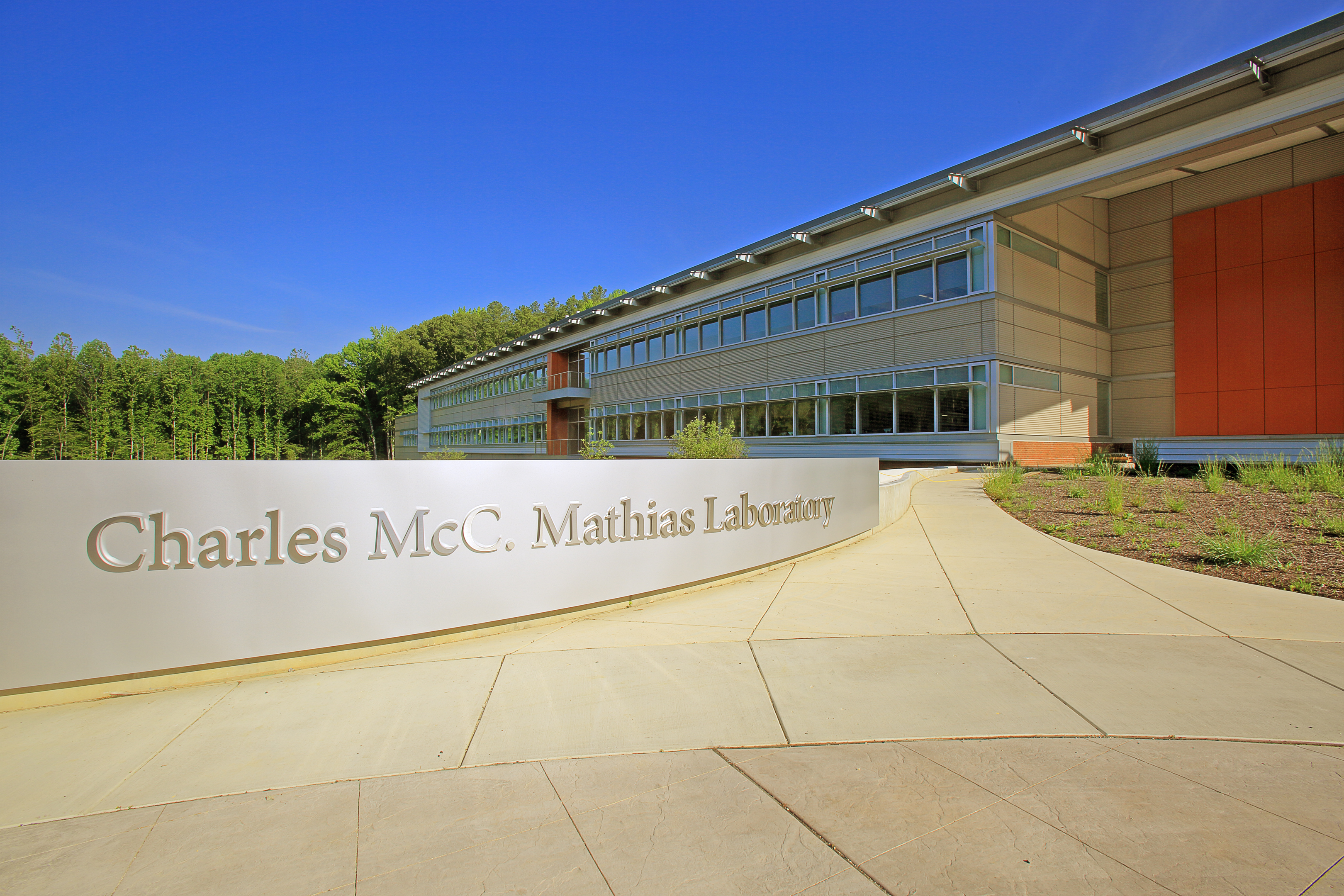
Drawing on geothermal and solar power, and other features such as automated lighting, the Mathias Lab is estimated to be 42 percent more energy efficient than a non-LEED-certified lab. (Photo by Chuck Gallegos)
The Smithsonian’s first-ever national fundraising campaign—the largest in history for a cultural institution—officially launched with a gala event in October. Three well-known philanthropists—David Rubenstein, Barbara Barrett and Alan Spoon—serve as co-chairs of the Smithsonian Campaign’s steering committee and leaders of the fundraising effort, which seeks to raise $1.5 billion. Smithsonian on its way to raising $1.5 billion–Yes, that’s Billion with a ‘B’ >>
November
Noah Cordle was boogie boarding in New Jersey when he came upon an ancient hunting tool. Noah, who is 10 years old and lives in Fairfax, Virginia, visited the National Museum of Natural History Nov. 3 to meet with archaeologists and donate his finding, which experts say is a Clovis point. The museum has several hundred in its collection – one of which was discovered as far back as the 1870s – but Noah’s is the first one to join the collection from New Jersey. And all we got on our summer vacation was sunburned. What I did on my summer vacation: Fifth grader unearths ancient artifact at the beach >>

Ten-year-old Noah Cordle visited the National Museum of Natural History on November 3 to donate a Clovis point he found in New Jersey. He and his parents (right) met with the museum’s Dennis Stanford (left). (Photo by Donald E. Hurlbert)
If you’ve ever redone your kitchen, you know how daunting home renovation can be. Now imagine a 20-year, $2 billion renovation project for one of the most historic and iconic buildings in the country. The Smithsonian announced Nov. 14 a dramatic plan to reimagine and revitalize several of its museums and gardens—including the iconic Castle—in what may be the most ambitious project on the National Mall in more than a century. Smithsonian announces dramatic new plan for National Mall museums >>
December
The Cooper Hewitt Smithsonian Design Museum reopened in New York on Dec 12 after a three-year renovation. The museum now boasts 60 percent more gallery space and offers an entirely new and invigorated visitor experience, with interactive, immersive creative technologies. How cool is the new design museum? Extremely cool, according to director Caroline Baumann. The new Cooper Hewitt experience >>
When you think of presidential portraits, the famous Lansdowne portrait of George Washington comes to mind—a steely-eyed statesman painted in oils amid the regalia of his office. But modern times call for modern methods of capturing the presidential likeness. For the first time in history, a portrait of a sitting president has been created using 3-D scanning technology. See out how a Smithsonian-led team of 3-D digital imaging specialists created the historic portraits. Up close and personal with POTUS >>
Secretary Wayne Clough retired at the end of December. The Institution has never seen “a more loving, joyful and creative sendoff” than the one that took place Dec. 8. If you missed the singing, dancing, confetti-strewn All-Staff meeting, here are the highlights. Thank you Dr. Clough!
Posted: 2 January 2015
-
Categories:
Art and Design , Collaboration , Feature Stories , History and Culture , Science and Nature

